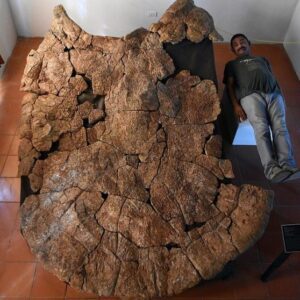The Tollund Man, a remarkably preserved 2,400-year-old mummy, was indeed a captivating discovery. He was found in a peat bog in Denmark in the 1950s. What makes Tollund Man particularly fascinating is the incredible preservation of his body due to the unique conditions of the bog.
The acidic and low-oxygen environment of peat bogs is ideal for preserving organic materials. Tollund Man’s body was so well-preserved that his facial features were still recognizable, giving researchers a rare glimpse into the appearance of an ancient individual. His serene expression led many to theorize about his manner of death, suggesting ritual sacrifice or execution.
The scientific and low-oxygen environment of peat bogs is ideal for preserving the contents of a person’s stomach, providing insights into the diet and lifestyle of an individual from ancient times. Tollund Man’s stomach contents were carefully analyzed, revealing clues about his last meal, which included a porridge made of various seeds.
A detailed analysis of Tollund Man’s body, clothing, and the items found with him has provided valuable insights into life during the Iron Age. The examination of his stomach contents also yielded information about his last moments, shedding light on the dietary habits of people in that era.
In conclusion, Tollund Man stands as a remarkable archaeological find, offering a unique window into the past and contributing significantly to our understanding of ancient civilizations.

On May 6, 1950, as Viggo and Emil Højgaard, peat cutters, ventured into the Bjælkebog Swamp, located 12 kilometers west of Silkeborg, Denmark, they encountered a bog body submerged about 10 feet beneath the water’s surface within the murky depths of the mud.

The lifelike facial expressions of the body initially led observers to mistake it for a recently deceased murder victim. Though in reality, they were gazing upon one of the planet’s most ancient mummified individuals.
The appellation “Tollund Man” was ascribed to him by archaeologists following the name of the village where the laborers rediscovered him. The cadaver was unclothed and reclined in a fetal stance, adorned with a cap made from sheepskin and a woolen belt fastened beneath its chin to maintain its jaw position. Even though he was devoid of trousers, he sported a belt. A layer of stubble was detected on his upper lip and chin, implying that he had shaved on the day prior to his demise.

The most captivating aspect amid the abundance of data was the braided animal skin noose, firmly cinched around the neck of Tollund Man, signifying his execution by hanging. Despite the cruelty of his demise, he exuded a serene countenance, his eyelids slightly shut, and his lips pressed together, as if engaged in a clandestine supplication.

It was during the period of the Irón Age, approximately around 3900 B.C., when farming had already been established in Europe by migrating farmers. This coincided with the time when human remains started to be interred in burial sites that covered the majority of the northern part of the continent, especially in the wetter regions.
Considering that cremation was a common method of disposing of the deceased during that epoch, experts concluded that the practice of burying bodies in the ground, especially in regions like Denmark, signified a cultural transition towards a distinct perception of death and a departure from the prevalent burial practices. In locations like Denmark, a significant number of unearthed bodies evidenced a cultural transition of burying individuals within the muddy grounds, suggesting a cultural transformation in the approach to death and burial practices in the majority of the surrounding regions.


The corpses consistently appeared untouched, with a garment or ornament present – much like Tollund Man, as detailed by archaeologist PV. Glob. They typically seemed secured in the peat bogs with a type of woven stick arrangement. This implies a deliberate effort to keep them in place without any chance of resurfacing, almost as if they were intended to remain in that position.
Analytical tests conducted on two Danish “bog mummies” unveiled that they had undergone substantial journeys prior to their demise, suggesting their origins were distant from the region. Karin Margarita Frei, a researcher at Denmark’s National Museum, speculated, “You offer a sacrificial victim of significant and valuable origin. It’s possible those who undertook the journey held true power.”
These bodies, buried beneath the ground for over 2,400 years, continue to astonish researchers due to their exceptional state of preservation, complete with hair, nails, and even recognizable facial expressions. Despite being exposed to a highly acidic acidic environment but also low oxygen levels, they remain relatively intact. Preservation techniques at play include anoxic burial conditions that inhibit bacterial activity, preventing decay.
The placement of these bodies occurred during winter or early spring when temperatures drop below freezing or are barely above, allowing swamp acids to immobilize tissues, hindering the decay process. This environment enables swamp bodies to saturate tissues, hindering the decay process. As layers of sphagnum moss perished, they released acids, further lowering the pH levels, which, combined with the oxygen deficiency, slows down the decomposition process.
As layers of sphagnum moss died, they released acids, further lowering the pH levels, which, combined with the oxygen deficiency, slows down the decomposition process. As layers of sphagnum moss perished, they released acids, further lowering the pH levels, which, combined with the oxygen deficiency, slows down the decomposition process.

While this “natural accident” effectively preserves skin, it also corrodes bones and the swampy water’s acidic conditions deteriorate human DNA, rendering genetic studies unreliable. In 1950, when Tollund Man underwent X-ray analysis, his brain was exceptionally well-preserved, but its structural integrity was severely compromised.
Despite this, the mummies’ soft tissues provided enough data to determine what their last meal was. Grauballe Man, for example, ate a porridge made from 60 different types of plants, containing enough rye spurs to poison him. Old Croghan, found in Ireland, ate a lot of meat, grain, and dairy before being brutally dispatched into the bog.
When they were alive, most of the swamp mummies were malnourished, but some displayed characteristics that indicate they had a high social status. On the other side, findings sometimes disagree with that interpretation. Miranda Aldhouse-Green, an archaeologist, believes that these unique characteristics may have led to their inclusion in high social circles.
Mud mummies have continued to appear over the years, but their number is as unknown as the circumstances under which they were buried, their bodies sinking and being buried with thousands of years of information.
Please note that this response may not fully capture the intended meaning, as the original text had a mix of complex language, potential typos, and the use of special characters that made the interpretation challenging. If you have specific questions or if there are further clarifications needed, feel free to ask.





